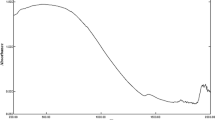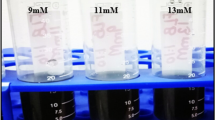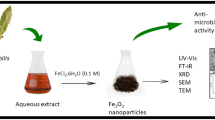Abstract
The green synthesis of nano-powders assumes great significance because of its high applicability and synthesis under ambient conditions via an amalgamation of plant-derived extracts. The formulation of small-sized iron particles using relatively underexplored curative fern Cheilanthes bicolor extract was investigated. The derivation of fern components was worked out, and anti-microbial efficacy was determined. This fern is rich in numerous phytochemicals like phenol, tannins, and reducing sugars which contributed in the generation of nano-iron particles. The effects of several decisive factors led to the optimal synthesis of the desired particles. The size, magnetic behavior, and physical aspects were elucidated by methods like UV–VIS spectrophotometry, Fourier-transform infrared spectroscopy (FTIR), field emission scanning electron microscopy (FESEM), dynamic light scattering (DLS), X-ray diffraction (XRD), and vibrating sample magnetometer (VSM). The findings revealed that the nanoparticles were amorphous in shape with an average size of 40–60 nm. These particles were tested against microorganisms and ultimately revealed their potency against diverse microflora. These iron nanoparticles demonstrated anti-microbial efficacy and displayed a MIC value of 6.25 µg/ml and 3.125 µg/ml against clinal pathogens Staphylococcus aureus and Escherichia coli, respectively.








Similar content being viewed by others
References
Barman, K., Dutta, P., Chowdhury, D., & Baruah, P. K. (2021). Green biosynthesis of copper oxide nanoparticles using waste colocasia esculenta leaves extract and their application as recyclable catalyst towards the synthesis of 1,2,3-triazoles. BioNanoScience, 11, 189–199. https://doi.org/10.1007/s12668-021-00826-5
Udhayan, S., Udayakumar, R., Sagayaraj, R., & Gurusamy, K. (2021). Evaluation of bioactive potential of a tragia involucrata healthy leaf extract @ ZnO nanoparticles. BioNanoScience, 11, 703–719. https://doi.org/10.1007/s12668-021-00864-z
Rao, K. J., Korumilli, T., Jakkala, S., & Singh, K. (2021). Optimization of the one-step green synthesis of silver and gold nanoparticles using aqueous Athyrium filix femina extract using the taguchi method. BioNanoScience, 11(4), 915–922. https://doi.org/10.1007/s12668-021-00909-3
Shehabeldine, A. M., Elbahnasawy, M. A., & Hasaballah, A. I. (2021). Green phytosynthesis of silver nanoparticles using Echinochloa stagnina extract with reference to their antibacterial, cytotoxic, and larvicidal activities. BioNanoScience, 11(2), 526–538. https://doi.org/10.1007/s12668-021-00846-1
Cai, J., Chen, S., Ji, M., Hu, J., Ma, Y., & Qi, L. (2014). Organic additive-free synthesis of mesocrystalline hematite nanoplates via two-dimensional oriented attachment. CrystEngComm, 16(8), 1553–1559. https://doi.org/10.1039/c3ce41716f
Cuong, N. D., Khieu, D. Q., Hoa, T. T., Quang, D. T., Viet, P. H., Lam, T. D., & …& Hieu, N. van. (2015). Facile synthesis of α-Fe2O3 nanoparticles for high-performance CO gas sensor. Materials Research Bulletin, 68, 302–307. https://doi.org/10.1016/j.materresbull.2015.03.069
Ebrahiminezhad, A., Varma, V., Yang, S., & Berenjian, A. (2016). Magnetic immobilization of Bacillus subtilis natto cells for menaquinone-7 fermentation. Applied Microbiology and Biotechnology, 100(1), 173–180. https://doi.org/10.1007/s00253-015-6977-3
Laurent, S., Dutz, S., Häfeli, U. O., & Mahmoudi, M. (2011). Magnetic fluid hyperthermia: Focus on superparamagnetic iron oxide nanoparticles. Advances in Colloid and Interface Science, 166(1–2), 8–23. https://doi.org/10.1016/j.cis.2011.04.003
Pan, Y., Du, X., Zhao, F., & Xu, B. (2012). Magnetic nanoparticles for the manipulation of proteins and cells. Chemical Society Reviews, 41(7), 2912–2942. https://doi.org/10.1039/c2cs15315g
Dobson, J. (2006). Gene therapy progress and prospects: Magnetic nanoparticle-based gene delivery. Gene Therapy, 13(4), 283–287. https://doi.org/10.1038/sj.gt.3302720
Busolo, M. A., & Lagaron, J. M. (2012). Oxygen scavenging polyolefin nanocomposite films containing an iron modified kaolinite of interest in active food packaging applications. Innovative Food Science and Emerging Technologies, 16, 211–217. https://doi.org/10.1016/j.ifset.2012.06.008
Ebrahiminezhad, A., Zare-Hoseinabadi, A., Sarmah, A. K., Taghizadeh, S., Ghasemi, Y., & Berenjian, A. (2018). Plant-mediated synthesis and applications of iron nanoparticles. Molecular Biotechnology, 60(2), 154–168. https://doi.org/10.1007/s12033-017-0053-4
Yang, J., Zou, P., Yang, L., Cao, J., Sun, Y., Han, D., & …& Kong, X. (2014). A comprehensive study on the synthesis and paramagnetic properties of PEG-coated Fe3O4 nanoparticles. Applied Surface Science, 303, 425–432. https://doi.org/10.1016/j.apsusc.2014.03.018
Zhao, X., Liu, W., Cai, Z., Han, B., Qian, T., & Zhao, D. (2016). An overview of preparation and applications of stabilized zero-valent iron nanoparticles for soil and groundwater remediation. Water Research, 100, 245–266. https://doi.org/10.1016/j.watres.2016.05.019
Beheshtkhoo, N., Kouhbanani, M. A. J., Savardashtaki, A., Amani, A. M., & Taghizadeh, S. (2018). Green synthesis of iron oxide nanoparticles by aqueous leaf extract of Daphne mezereum as a novel dye removing material. Applied Physics A, 124(5), 363. https://doi.org/10.1007/s00339-018-1782-3
Aghajani, Z., Engashte-Vahed, A. A., & Zand-Monfared, M. R. (2017). Biosynthesized Fe3O4 nanoparticles: It’s magnetic and photocatalysis properties. Journal of Materials Science: Materials in Electronics, 28(22), 17338–17343. https://doi.org/10.1007/s10854-017-7666-z
Chauhan, S., Seth, C. A., & Seth, A. (2015). Bioprospecting thermophilic microorganisms from hot springs of western Himalayas for xylanase production and its statistical optimization by using response surface methodology. Journal of Pure and Applied Microbiology, 9(2): 1417–1428. https://www.researchgate.net/publication/283819292
Singh, P., Kumari, A., Attri, C., & Seth, A. (2019). Efficient lactamide synthesis by fed-batch method using nitrile hydratase of Rhodococcus pyridinivorans NIT-36. Journal of Microbiology, Biotechnology and Food Sciences, 9(3), 567–572. https://doi.org/10.15414/jmbfs.2019/20.9.3.567-572
Singh, P., Kumari, A., Chauhan, K., Attri, C., & Seth, A. (2020). Nitrile hydratase mediated green synthesis of lactamide by immobilizing Rhodococcus pyridinivorans NIT-36 cells on N, N′-Methylene bis-acrylamide activated chitosan. International Journal of Biological Macromolecules, 161, 168–176. https://doi.org/10.1016/j.ijbiomac.2020.06.004
Din, M. I., & Rani, A. (2018). Selection of optimum strategies for the fabrication of plant-mediated metal nanoparticles: Emerging problems in sustainability. Critical Reviews in Analytical Chemistry, 48(5), 406–415. https://doi.org/10.1080/10408347.2018.1444464
Lohrasbi, S., Kouhbanani, M. A. J., Beheshtkhoo, N., Ghasemi, Y., Amani, A. M., & Taghizadeh, S. (2019). Green synthesis of iron nanoparticles using Plantago major leaf extract and their application as a catalyst for the decolorization of azo dye. BioNanoScience, 9(2), 317–322. https://doi.org/10.1007/s12668-019-0596-x
Mahanty, S., Bakshi, M., Ghosh, S., Chatterjee, S., Bhattacharyya, S., Das, P., …, & Chaudhuri, P. (2019). Green synthesis of iron oxide nanoparticles mediated by filamentous fungi isolated from Sundarban mangrove ecosystem, India. BioNanoScience, 9(3), 637–651. https://doi.org/10.1007/s12668-019-00644-w
Rawat, S., & Singh, J. (2021). Green synthesis of iron nanoparticles using Plumeria and Jatropha: Characterization and investigation of their adsorption, regeneration and catalytic degradation Efficiencies. BioNanoScience, 11(4), 1142–1153. https://doi.org/10.1007/s12668-021-00894-7
Sutradhar, P., Saha, M., & Maiti, D. (2014). Microwave synthesis of copper oxide nanoparticles using tea leaf and coffee powder extracts and its antibacterial activity. Journal of Nanostructure in Chemistry, 4(1), 1–6. https://doi.org/10.1007/s40097-014-0086-1
Rajput, N. (2015). Methods of preparation of nanoparticles-A review. International Journal of Advances in Engineering & Technology, 7, 1806–1811.
Atarod, M., Nasrollahzadeh, M., & Sajadi, S. M. (2016). Green synthesis of Pd/RGO/Fe3O4 nanocomposite using Withania coagulans leaf extract and its application as magnetically separable and reusable catalyst for the reduction of 4-nitrophenol. Journal of Colloid and Interface Science, 465, 249–258. https://doi.org/10.1016/j.jcis.2015.11.060
Seth, M. K., Seth, A., & Negi, H. C. (2004a). Pteridophytic flora of Kinnaur, Himachal Pradesh Part-I: A general account of Kinnaur District and eight species belonging to suborder Pteridineae of order Pteridales. Indian Fern Journal, 21, 45–62. https://www.researchgate.net/publication/343254287
Seth, M. K., Seth, A., & Negi, H. C. (2004b). Pteridophytic flora of Kinnaur, Himachal Pradesh. Part II: 13 common pteridophytes belonging to families Hypodematiaceae, Athyriaceae, Dryopteridaceae, Selaginellaceae and Equisetaceae. Indian Fern Journal, 21, 63–80. https://www.researchgate.net/publication/343254671
Seth M. K., Seth A., & Negi H. C. (2004c). Pteridophytic flora of Kinnaur, Himachal Pradesh. Part III: Nine common Pteridophytes belonging to families Dennstaedtiaceae, Thelypteridaceae and Aspleniaceae. Phytotaxonomy 4: 25–35. Phytotaxonomy, 4, 25–35. https://www.researchgate.net/publication/343255187
Singh, S. K., & Rajkumar, S. D. (2017). Biodiversity and indigenous use of medicinal ferns in Chandraprabha Wildlife Sanctuary, Chandauli, Uttar Pradesh. International Journal of Research Studies in Biosciences, 5(11), 19–25. https://doi.org/10.20431/2349-0365.0511004
Goswami, H. K., Sen, K., & Mukhopadhyay, R. (2016). Pteridophytes: Evolutionary boon as medicinal plants. Plant Genetic Resources, 14(4), 328–355. https://doi.org/10.1017/S1479262116000290
Asghar, M. A., Zahir, E., Shahid, S. M., Khan, M. N., Asghar, M. A., Iqbal, J., & Walker, G. (2018). Iron, copper and silver nanoparticles: Green synthesis using green and black tea leaves extracts and evaluation of antibacterial, antifungal and aflatoxin B1 adsorption activity. LWT, 90, 98–107. https://doi.org/10.1016/j.lwt.2017.12.009
Harborne, J. B. (1984). Methods of plant analysis. In: Phytochemical Methods. Springer, Dordrecht. Pp. 1–36. https://doi.org/10.1007/978-94-009-5570-7_1
Wang, T., Jin, X., Chen, Z., Megharaj, M., & Naidu, R. (2014). Green synthesis of Fe nanoparticles using eucalyptus leaf extracts for treatment of eutrophic wastewater. Science of the Total Environment, 466–467, 210–213. https://doi.org/10.1016/j.scitotenv.2013.07.022
Jyoti, B., & K., Chauhan, K., Attri, C., & Seth, A. (2017). Improving stability and reusability of Rhodococcus pyridinivorans NIT-36 nitrilase by whole cell immobilization using chitosan. International Journal of Biological Macromolecules, 103, 8–15. https://doi.org/10.1016/j.ijbiomac.2017.05.012
Rao, N. H., Lakshmidevi, N., Pammi, S. V. N., Kollu, P., Ganapaty, S., & Lakshmi, P. (2016). Green synthesis of silver nanoparticles using methanolic root extracts of Diospyros paniculata and their antimicrobial activities. Materials Science and Engineering C, 62, 553–557. https://doi.org/10.1016/j.msec.2016.01.072
Ban, S. H., Kim, J. E., Pandit, S., & Jeon, J. G. (2012). Influences of Dryopteris crassirhizoma extract on the viability, growth and virulence properties of Streptococcus mutans. Molecules, 17(8), 9231–9244. https://doi.org/10.3390/molecules17089231
Ghosh, P. G., Mukhopadhyay, R., & Gupta, K. (2005). Antifungal activity of the crude extracts and extracted phenols from gametophytes and sporophytes of two species of Adiantum. Taiwania, 50(4), 272–283. https://doi.org/10.6165/tai.2005.50(4).272
Iwashina, T., & Matsumoto, S. (2011). Flavonoid properties of six Asplenium Species in Vanuatu and New Caledonia, and distribution of flavonoid and related compounds in Asplenium. Bulletin of the National Museum of Nature and Science, Series B, 37(3), 133–145. https://www.researchgate.net/publication/284687965
Kardong, D., Upadhyaya, S., & Saikia, L. R. (2013). Screening of phytochemicals, antioxidant and antibacterial activity of crude extract of Pteridium aquilinum Kuhn. Journal of Pharmacy Research, 6(1), 179–182. https://doi.org/10.1016/j.jopr.2012.11.037
Paul, K. R., Irudayaraj, V., Johnson, M., & Patric, D. R. (2011). Phytochemical and anti-bacterial activity of epidermal glands extract of Christella parasitica (L.) H. Lev. Asian Pacific Journal of Tropical Biomedicine, 1(1), 8–11. https://doi.org/10.1016/S2221-1691(11)60059-2
Niranjan Reddy, V. L., Ravikanth, V., Prabhakar Rao, T., Diwan, P., & v., & Venkateswarlu, Y. (2001). A new triterpenoid from the fern Adiantum lunulatum and evaluation of antibacterial activity. Phytochemistry, 56(2), 173–175. https://doi.org/10.1016/S0031-9422(00)00334-4
Zheng, X. K., Li, Y. J., Zhang, L., Feng, W. S., & Zhang, X. (2011). Antihyperglycemic activity of Selaginella tamariscina (Beauv.) Spring. Journal of Ethnopharmacology, 133(2), 531–537. https://doi.org/10.1016/j.jep.2010.10.028
Bhatia, K., Mal, G., Bhar, R., Jyoti, A., & C., & Seth, A. (2018). Purification and characterization of thermostable superoxide dismutase from Anoxybacillus gonensis KA 55 MTCC 12684. International Journal of Biological Macromolecules, 117, 1133–1139. https://doi.org/10.1016/j.ijbiomac.2018.06.031
Manhas, S., Attri, C., Seth, M.K., & Seth, A. (2018). Determination of phytochemical constituents and evaluation of antimicrobial activity of medicinal fern Christella dentata Indian Fern Journal 35: 169–178. https://www.researchgate.net/publication/343255848
Guo, L., Huang, Q., Li, X. Y., & Yang, S. (2001). Iron nanoparticles: Synthesis and applications in surface enhanced Raman scattering and electrocatalysis. Physical Chemistry Chemical Physics, 3(9), 1661–1665. https://doi.org/10.1039/b009951l
Zhou, Z. H., Wang, J., Liu, X., & Chan, H. S. O. (2001). Synthesis of Fe3O4 nanoparticles from emulsions. Journal of Materials Chemistry, 11(6), 1704–1709. https://doi.org/10.1039/b100758k
Devatha, C. P., Thalla, A. K., & Katte, S. Y. (2016). Green synthesis of iron nanoparticles using different leaf extracts for treatment of domestic waste water. Journal of Cleaner Production, 139, 1425–1435. https://doi.org/10.1016/j.jclepro.2016.09.019
Weng, X., Huang, L., Chen, Z., Megharaj, M., & Naidu, R. (2013). Synthesis of iron-based nanoparticles by green tea extract and their degradation of malachite. Industrial Crops and Products, 51, 342–347. https://doi.org/10.1016/j.indcrop.2013.09.024
Pecora, R. (2000). Dynamic light scattering measurement of nanometer particles in liquids. Journal of Nanoparticle Research, 2(2), 123–131. https://doi.org/10.1023/A:1010067107182
Kulkarni, J. N., Dauthal, P., & Mukhopadhyay, M. (2015). Green synthesis of iron complex nanoparticles using Delonix regia leaf. In 68th Annual Session of Indian Institute of Chemical Engineers (pp. 1–6). Guwahati. https://www.researchgate.net/publication/290426479
Jans, H., Liu, X., Austin, L., Maes, G., & Huo, Q. (2009). Dynamic light scattering as a powerful tool for gold nanoparticle bioconjugation and biomolecular binding studies. Analytical Chemistry, 81(22), 9425–9432. https://doi.org/10.1021/ac901822w
Zhang, D. E., Tong, Z. W., Li, S. Z., Zhang, X. B., & Ying, A. (2008). Fabrication and characterization of hollow Fe3O4 nanospheres in a microemulsion. Materials Letters, 62(24), 4053–4055. https://doi.org/10.1016/j.matlet.2008.05.023
Acknowledgements
The authors are highly thankful to the Honourable Vice-Chancellor, Prof. P. K. Khosla, for the necessary facilities to carry out this research work.
Funding
This work was supported by the Science and Engineering Research Board (SERB), Department of Science and Technology, Government of India (Grant No.: SB/YS/LS-19/2013).
Author information
Authors and Affiliations
Corresponding author
Ethics declarations
Research Involving Humans and Animals Statement
None.
Informed Consent
None.
Conflict of Interest
The authors declare no competing interests.
Additional information
Publisher's Note
Springer Nature remains neutral with regard to jurisdictional claims in published maps and institutional affiliations.
Rights and permissions
About this article
Cite this article
Seth, A., Devi, E., Thakur, K. et al. Himalayan Fern Cheilanthes bicolor Mediated Fabrication and Characterization of Iron Nanoparticles with Antimicrobial Potential. BioNanoSci. 12, 486–495 (2022). https://doi.org/10.1007/s12668-022-00969-z
Accepted:
Published:
Issue Date:
DOI: https://doi.org/10.1007/s12668-022-00969-z




